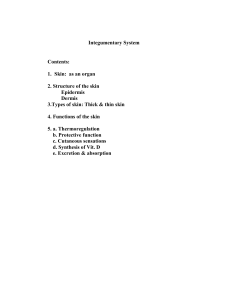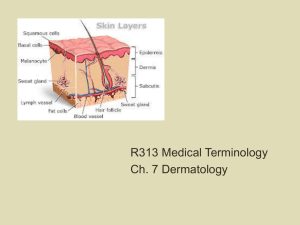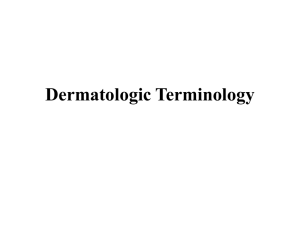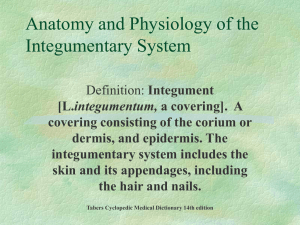Clinical History: Papule on thigh of a 50 year
advertisement
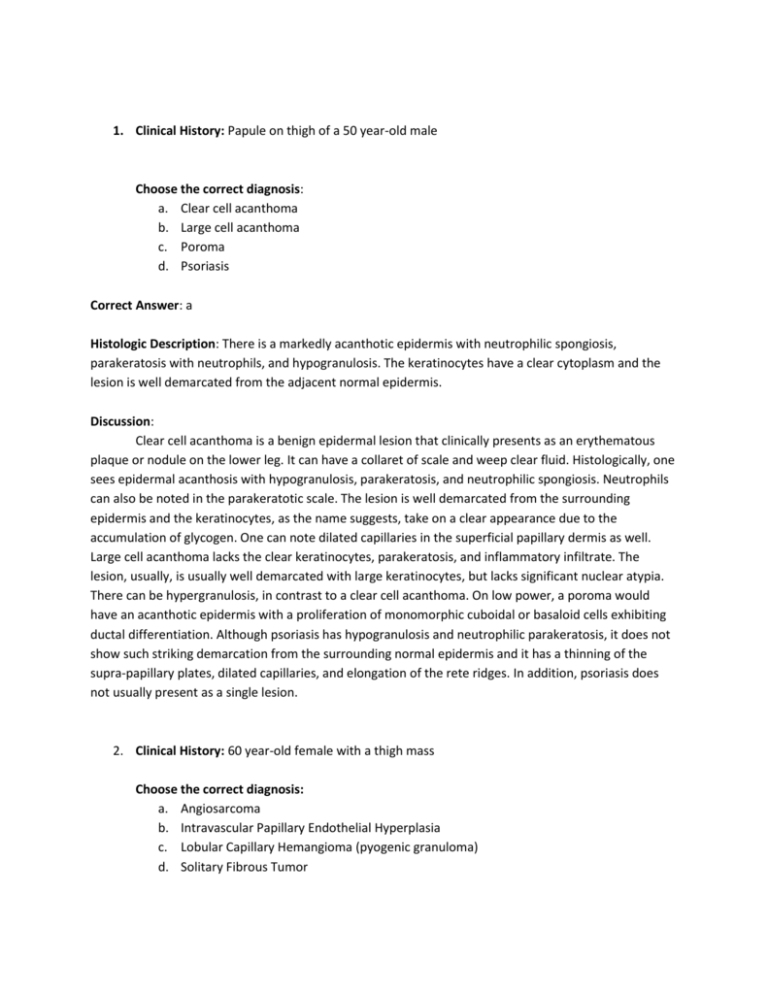
1. Clinical History: Papule on thigh of a 50 year-old male Choose the correct diagnosis: a. Clear cell acanthoma b. Large cell acanthoma c. Poroma d. Psoriasis Correct Answer: a Histologic Description: There is a markedly acanthotic epidermis with neutrophilic spongiosis, parakeratosis with neutrophils, and hypogranulosis. The keratinocytes have a clear cytoplasm and the lesion is well demarcated from the adjacent normal epidermis. Discussion: Clear cell acanthoma is a benign epidermal lesion that clinically presents as an erythematous plaque or nodule on the lower leg. It can have a collaret of scale and weep clear fluid. Histologically, one sees epidermal acanthosis with hypogranulosis, parakeratosis, and neutrophilic spongiosis. Neutrophils can also be noted in the parakeratotic scale. The lesion is well demarcated from the surrounding epidermis and the keratinocytes, as the name suggests, take on a clear appearance due to the accumulation of glycogen. One can note dilated capillaries in the superficial papillary dermis as well. Large cell acanthoma lacks the clear keratinocytes, parakeratosis, and inflammatory infiltrate. The lesion, usually, is usually well demarcated with large keratinocytes, but lacks significant nuclear atypia. There can be hypergranulosis, in contrast to a clear cell acanthoma. On low power, a poroma would have an acanthotic epidermis with a proliferation of monomorphic cuboidal or basaloid cells exhibiting ductal differentiation. Although psoriasis has hypogranulosis and neutrophilic parakeratosis, it does not show such striking demarcation from the surrounding normal epidermis and it has a thinning of the supra-papillary plates, dilated capillaries, and elongation of the rete ridges. In addition, psoriasis does not usually present as a single lesion. 2. Clinical History: 60 year-old female with a thigh mass Choose the correct diagnosis: a. Angiosarcoma b. Intravascular Papillary Endothelial Hyperplasia c. Lobular Capillary Hemangioma (pyogenic granuloma) d. Solitary Fibrous Tumor Correct Answer: c Histologic Description: In the deep reticular dermis, one sees a well circumscribed lobulated collection of thin walled vessels in a fibrotic stroma. The epidermis is unremarkable. Nuclear atypia and mitoses are not seen. Discussion: Pyogenic granuloma is a benign, reactive vascular proliferation which occurs in response to trauma. It is commonly seen on the head and neck or distal extremities. It is not uncommon in the pediatric population and gingival lesions can occur in pregnancy. Clinical presentation is usually that of a juicy, erythematous, friable papule or nodule that bleeds easily. They can occur deep within the skin and have a violaceous color, which may be mistaken for melanoma. Histologically, they typically occur in the papillary dermis, but they can occur in the reticular dermis or intravascularly. The lesion has a well circumscribed collection of thin walled capillaries that can take on a lobulated appearance. Superficial lesions have a collarette of scale. The surrounding stroma may have a myxoid and edematous appearance with occasional mast cells and stellate fibroblasts. Fibrosis may be seen in involuting lesions. Angiosarcoma would show a poorly formed vessels dissecting between collagen fibers in the dermis with prominent nuclear atypia and mitoses. Intravascular papillary endothelial hyperplasia would not show such well formed vessels and can be associated with a thrombus within a larger vessel. A solitary fibrous tumor shows a proliferation of spindle cells in a pattern-less pattern associated with staghorn vessels. 3. Clinical History: 15 year-old female with a papule on the chin Choose the correct answer: a. Dermatofibroma (Fibrous Histiocytoma) b. Juvenile Xanthogranuloma c. Necrobiotic Xanthogranuloma d. Xanthoma Correct Answer: b Histologic Description: Beneath a normal epidermis one sees a collection of foamy histiocytes and giant cells with a wreath-like configuration of nuclei. Discussion: Juvenile Xanthogranuloma (JXG) is a benign histiocytic lesion that usually occurs in childhood and presents as a reddish-brown papule involving the head and neck area, but other sites can be involved. Multiple lesions may be associated with neurofibromatosis and juvenile chronic myelogenous leukemia. Visceral involvement may occur, but this is rare. Histologically, one typically sees a well circumscribed dome shaped lesion in the superficial dermis consisting of foamy histiocytes and giant cells that have nuclei in a wreath configuration (Touton giant cells). Neutrophils, lymphocytes, and eosinophils may be interspersed throughout the lesion. Necrobiotic xanthogranuloma (NXG) may show Touton like giant cells, but one usually sees striking necrobiotic change throughout the dermis associated with extracellular cholesterol deposits. NXG typically presents in adults and is associated with monoclonal gammopathy. Xanthomas have foamy histiocytes, but lack Touton giant cells. Although dermatofibromas may have xanthomatized histiocytes, they usually have the characteristic collagen wrapping configuration associated with peudoepitheliomatous hyperplasia and basal layer hyperpigmentation. 4. Clinical History: 60 year-old male with a papule on the nose Choose the correct answer: a. Inverted Follicular Keratosis b. Squamous Cell Carcinoma c. Trichilemmoma d. Verruca Vulgaris Correct Answer: c Histologic Description: There is a markedly acanthotic epidermis with clear keratinocytes and peripherally there one notes basaloid cells in a palisading pattern. Discussion: A trichilemmoma is a benign epidermal growth that derives from the follicular infundibulum and shows outer root sheath differentiation. They are characteristically found on the face and multiple lesions are associated with Cowden’s syndrome. Histologically, one sees a well demarcated, lobulated epidermal proliferation of keratinocytes with cytoplasmic clearing due to glycogen accumulation. The lesion is enveloped by basophilic columnar cells arranged in a palisaded fashion and eosinophilic basement membrane mimicking the outer root sheath of the hair follicle. Desmoplastic trichilemmomas are similar but are also accompanied by an abutting desmoplastic stroma. A squamous cell carcinoma would show prominent nuclear atypia and lacks the palisading of a trichilemmoma. Inverted follicular keratosis shows a verrucoid lesion with whorls of glassy keratinocytes at the base. Verruca vulgaris is characterized by koilocytes with pyknotic nuclei and cytoplasmic clearing commonly found in the expanded granular layer. 5. Clinical History: 90 year old male with a mass in the axilla Choose the correct answer: a. Nodular hidradenoma (acrospiroma) b. Sebaceous adenoma c. Sebaceous carcinoma d. Sebaceous epithelioma Correct Answer: d Histologic Description: Deep in the reticular dermis, one notes a well circumscribed tumor consisting of basaloid cells. Occasional cells with a vacuolar cytoplasm that indents the nucleus are seen. Scattered mitoses are seen, but the cells lack prominent nuclear atypia. Discussion: Sebaceous epithelioma (sebaceoma) is a sebaceous tumor that typically involves the head and neck area. It clinically presents as yellowish nodule or plaque. Microscopically, they consist of well circumscribed proliferation of lobules or nests of blue cells representing immature sebocytes admixed with more differentiated cells showing clear sebaceous differentiation. Typically more than half the lesion will consist of these immature germinative cells. Mitoses can be found, but are not indicative of malignancy. Nuclear atypia is absent or rare, and one should be suspicious of sebaceous carcinoma in more atypical lesions. Multiple lesions can be associated with Muir-Torre syndrome. Sebaceous adenomas can show similar histology, but the structure of the normal sebaceous gland is usually retained. In a sebaceous adenoma the number of well differentiated sebaceous cells outnumbers the immature sebocytes, which tend to be found at the periphery of the lesion and mature inwards. An acrospiroma consists of lobules of blue cells with ductal differentiation admixed with cells that have clear or squamoid differentiation. Nodular hidradenoma is thought to be eccrine of origin and does not show sebaceous differentiation. 6. Clinical History: 80 year old male with a recent eruption of vesicles on the forearm Choose the correct answer: a. Coxsackie Virus infection b. Herpes Simplex/Varicella Zoster Virus infection c. Molluscum Contagiosum d. Orf Answer: b Histologic Description: The epidermis shows marked reticular and ballooning degeneration. Keratinocytes with steel gray nuclei and multi-nucleated giant cells are seen. Discussion: Herpes Simplex (Types 1 and 2) and Varicella Zoster virus have the same characteristic histology. The main changes include: ballooning and reticular degeneration of the epidermis ( a sign suggestive of viral disease), steel gray keratinocyte nuclear inclusions with margination of the chromatin, multinucleated keratinocyte with nuclear molding, and leukocytoclastic vasculitis in the papillary dermis. Coxsackie viruses (typically A16) are the cause of hand-foot-mouth syndrome. The low power view is similar to HSV infection with prominent reticular and ballooning degeneration, but multinucleated giant cells and nuclear inclusions are not seen. Molluscum Contagiosum is a superficial Parapox infection with characteristic cytoplasmic eosinophilic-basophilic inclusions (Henderson-Patterson bodies). Orf (ecthyma contagiosum) is a Parapox infection acquired from sheep or goats. The lesion usually progresses through several stages: macular, target, weeping, nodular, verrucous, and regressive. On histology, one notes reticular degeneration with both cytoplasmic and nuclear eosinophilic inclusions (HSV is only nuclear).



